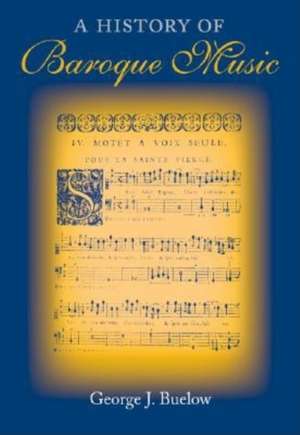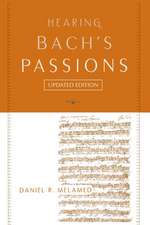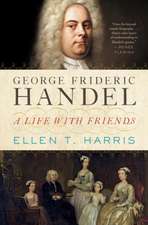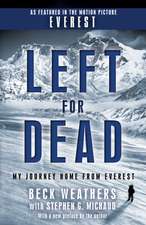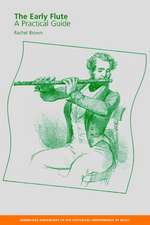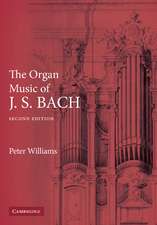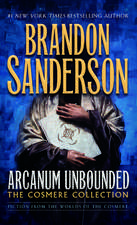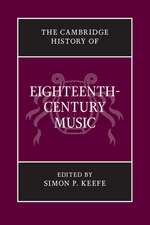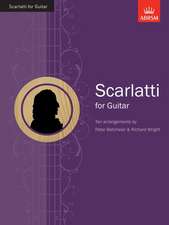A History of Baroque Music
Autor George J. Buelowen Limba Engleză Hardback – 22 noi 2004
Contributors are Claudia Jensen, Metoda Kokole, Rui Vieira Nery, and Ennio Stipcevic."
Preț: 483.51 lei
Preț vechi: 627.94 lei
-23% Nou
Puncte Express: 725
Preț estimativ în valută:
92.53€ • 96.25$ • 76.39£
92.53€ • 96.25$ • 76.39£
Carte tipărită la comandă
Livrare economică 14-28 aprilie
Preluare comenzi: 021 569.72.76
Specificații
ISBN-13: 9780253343659
ISBN-10: 0253343658
Pagini: 720
Dimensiuni: 187 x 262 x 43 mm
Greutate: 1.63 kg
Editura: MH – Indiana University Press
Locul publicării:United States
ISBN-10: 0253343658
Pagini: 720
Dimensiuni: 187 x 262 x 43 mm
Greutate: 1.63 kg
Editura: MH – Indiana University Press
Locul publicării:United States
Cuprins
Preface
Acknowledgements
Introduction: "Baroque" as an historical concept
Part I: The Baroque in the Seventeenth Century
Chapter 1: The Renaissance in Transition-Origins of New Musical concepts
Chapter 2: Baroque Innovations in Italy to circa 1640
Chapter 3: Claudio Monteverdi (1567=1643)
Chapter 4: The Baroque in Italy from c1640 to c1700
Chapter 5: Arcangelo Corelli (1653-1713 and Alessandro Scarlatti (1660-1725)
George J. Buelow
Chapter 6: The Baroque in France
Chapter 7: Sacred Music in Northern and Southern Europe and Austria in the Seventeenth Century
Chapter 8: Secular Music in Northern and Southern Europe and Austria in the Seventeenth Century
Chapter 9: Heinrich Schütz (1585-1672)
Chapter 10: English Music during the Stuart Reign, the Commonwealth and the Restoration
Chapter 11: Henry Purcell (1659-1695)
Chapter 12: Music in Spain, Portugal, and Latin America
By Rui Vieira Nery
Chapter 13: Music in Eastern Europe
by Ennio Stipcevic, Metoda Kokole, and Claudia Jensen
Part II: The Baroque in Transition
Chapter 14: Music in Italy
Chapter 15: Opera at Hamburg, Dresden, and Vienna
Chapter 16: George Frideric Handel (1685-1759)
Chapter 17: Johann Sebastian Bach (1685-1750)
Chapter 18: Georg Philipp Telemann (1681-1767)
Bibliography
Index
List of Contributors
Acknowledgements
Introduction: "Baroque" as an historical concept
Part I: The Baroque in the Seventeenth Century
Chapter 1: The Renaissance in Transition-Origins of New Musical concepts
Chapter 2: Baroque Innovations in Italy to circa 1640
Chapter 3: Claudio Monteverdi (1567=1643)
Chapter 4: The Baroque in Italy from c1640 to c1700
Chapter 5: Arcangelo Corelli (1653-1713 and Alessandro Scarlatti (1660-1725)
George J. Buelow
Chapter 6: The Baroque in France
Chapter 7: Sacred Music in Northern and Southern Europe and Austria in the Seventeenth Century
Chapter 8: Secular Music in Northern and Southern Europe and Austria in the Seventeenth Century
Chapter 9: Heinrich Schütz (1585-1672)
Chapter 10: English Music during the Stuart Reign, the Commonwealth and the Restoration
Chapter 11: Henry Purcell (1659-1695)
Chapter 12: Music in Spain, Portugal, and Latin America
By Rui Vieira Nery
Chapter 13: Music in Eastern Europe
by Ennio Stipcevic, Metoda Kokole, and Claudia Jensen
Part II: The Baroque in Transition
Chapter 14: Music in Italy
Chapter 15: Opera at Hamburg, Dresden, and Vienna
Chapter 16: George Frideric Handel (1685-1759)
Chapter 17: Johann Sebastian Bach (1685-1750)
Chapter 18: Georg Philipp Telemann (1681-1767)
Bibliography
Index
List of Contributors
Recenzii
Given the availability of numerous sophisticated surveys on Baroque music history, this reviewer was astonished that this tome exceeded expectations regarding scope and focus. In an effort to offer a discussion that goes beyond the standard canon of thought, Buelow (emer., Indiana Univ.) explores the works of Iberian, Eastern European, Latin American, and indeed even Caribbean composers. The book is replete with extensive score excerpts and analysis, and the chapters are subdivided into sections treating genre, composer, and technical development--an arrangement that makes this sizeable volume painless to navigate. Some of the most complex issues confronting the author are the paradigm shifts away from the knotty theoretical and philosophical concerns of the Renaissance establishment. Buelow excels in handling this, offering a chapter about this transition that even the uninitiated will be able to comprehend. His portrayal of the cross--cultural ramifications resulting from the contemporary political condition brings with it needed context for tracing musical developments as they occur across the Continent. Though the seemingly obligatory Bach and Handel chapters are somewhat overextended, this is a solid addition to the literature. Summing Up: Essential. Upper--division undergraduates through faculty and professionals. --J. Rubin, University of Minnesot--Duluth, 2005jun CHOICE
Notă biografică
George J. Buelow, Professor Emeritus of Musicology at Indiana University, is former President of the American Bach Society. His research and publications, including several articles in The New Grove Dictionary of Music and Musicians, focus on the music of the Baroque and the history of opera.
Descriere
A comprehensive survey of Baroque music, thoroughly illustrated with almost 200 musical examples
